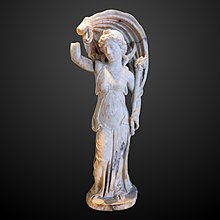
Back لونا Arabic Luna BAR Luna (mitologia) Catalan Luna (bohyně) Czech Luna (mytologi) Danish Luna German Λούνα Greek لونا (ایزد بانو) Persian Luna (jumalatar) Finnish Luna (mythologie) French
| Luna | |
|---|---|
Goddess of the Moon | |
 Luna (AD 150–200, Musée d'Art et d'Histoire de Genève) | |
| Planet | Moon[1] |
| Symbol | Chariot, crescent moon |
| Day | Monday (dies Lunae) |
| Temples | Aventine Hill, Palatine Hill |
| Genealogy | |
| Siblings | Sol, Aurora |
| Equivalents | |
| Greek | Selene |
| Indo-European | Meh₁not |
In Sabine and ancient Roman religion and myth, Luna is the divine embodiment of the Moon (Latin Lūna [ˈɫ̪uːnä]). She is often presented as the female complement of the Sun, Sol, conceived of as a god. Luna is also sometimes represented as an aspect of the Roman triple goddess (diva triformis), along with Diana and either Proserpina or Hecate. Luna is not always a distinct goddess, but sometimes rather an epithet that specializes a goddess, since both Diana and Juno are identified as moon goddesses.[2]
In Roman art, Luna attributes are the crescent moon plus the two-yoke chariot (biga). In the Carmen Saeculare, performed in 17 BC, Horace invokes her as the "two-horned queen of the stars" (siderum regina bicornis), bidding her to listen to the girls singing as Apollo listens to the boys.[3]
Varro categorized Luna and Sol among the visible gods, as distinguished from invisible gods such as Neptune, and deified mortals such as Hercules.[4] She was one of the deities Macrobius proposed as the secret tutelary of Rome.[5] In Imperial cult, Sol and Luna can represent the extent of Roman rule over the world, with the aim of guaranteeing peace.[6]
Luna's Greek counterpart was Selene. In Roman art and literature, myths of Selene are adapted under the name of Luna. The myth of Endymion, for instance, was a popular subject for Roman wall painting.[7]
- ^ Evans, James (1998). The History and Practice of Ancient Astronomy. Oxford University Press. pp. 296–7. ISBN 978-0-19-509539-5. Retrieved 4 February 2008.
- ^ C.M.C. Green, Roman Religion and the Cult of Diana at Aricia (Cambridge University Press, 2007), p. 73.
- ^ Horace, Carmen Saeculare, lines 33–36.
- ^ Varro, frg. 23 (Cardauns) = Tertullian, Ad nationes 2.2.14–2-; Attilio Mastrocinque, "Creating One's Own Religion: Intellectual Choices," in A Companion to Roman Religion, p. 383.
- ^ Jörg Rüpke, Religion of the Romans, p. 133.
- ^ William Van Andringa, "Religion and the Integration of Cities in the Empire in the Second Century AD: The Creation of a Common Religious Language," in A Companion to Roman Religion (Blackwell, 2007), p. 94.
- ^ Annemarie Kaufmann-Heinimann, "Religion in the House", in A Companion to Roman Religion, p. 188.